The NIH Research Centers in Minority Institutions (RCMI): National and Public Health Impact as Measured by Collaborative Scientific Excellence, Investigator Development, and Community Engagement
Abstract
1. Introduction
1.1. Legislative History of the RCMI Program [1]
“The Research Centers in Minority Institutions Review Committee shall advise on programs and activities in minority institutions. This program is designed to expand the Nation’s capacity for conducting research by strengthening the research environment at predominantly minority institutions offering doctorates in the health professions or health-related sciences. The program provides awards to broaden significantly the biomedical and behavioral research capability of minority institutions by support of core research laboratories, faculty expansion and enrichment, development or upgrading of physical facilities, development of investigations in the use of state-of-the-art scientific equipment and instrumentation, and scientific exchange through symposia and workshops. The long-term goal is to enhance the ability of faculty members to compete individually or collectively for independent research grant support.”
“Research Centers in Minority Institutions The Committee continues to recognize the critical role played by minority institutions, especially at the graduate level, in addressing the health research and training needs of minority populations. In particular, the RCMI program fosters the development of new generations of minority scientists for the Nation and provides support for crucial gaps in the biomedical workforce pipeline. The RCMI program has the capability to promote solutions to the significant gap in R01 grant funding among Black and other minority researchers when compared to non-minority researchers.”
1.2. Organization of the RCMI Consortium and the Role of the RCMI Coordinating Center
1.3. RCMI Consortium Governance, Communication, and Coordination [6]
1.4. RCMI Consortium Centralized Profiles Database for Collaboration and Data Collection
2. Materials and Methods
2.1. Retrieving RCMI Research Projects and Publications Using the NIH RePORTER Database/API and PubMed API to Search RCMI Research Projects (R01 and R01 Equivalent Funding)
2.2. RCMI Publications and Publications Acknowledging RCMI Grant Awards
- Activity Code (e.g., U54): Represents the specific category of support (e.g., research projects, fellowships, etc.). In this example, “U54” refers to a “Specialized Center—Cooperative Agreement.”
- Institute/Center Code (e.g., MD): Identifies the NIH Institute/Center (IC) associated with the grant. The “MD” code, for example, corresponds to the National Institute on Minority Health and Health Disparities (NIMHD).
- Serial Number: A unique identifier assigned by the NIH Center for Scientific Review (CSR) to distinguish the specific grant application.
2.3. Return on Investment (ROI) of the RCMI Program
2.4. RCMI Inter-Institutional Collaboration and Research Networking Resources
2.5. Other Data Sources and Analysis
2.6. RCMI Centers At-a-Glance
2.7. Other Metrics Tracked to Demonstrate Success, National and Public Health National Impact
2.8. Equitable Breakthroughs in Medicine Development (EQBMED) Renamed the Clinical Trials Access Collaborative (CTAC)
3. Results
3.1. RCMI Grantee Institutions with Active Specialized Research Center Awards (See Figure 2)
3.2. RCMI Inter-Institutional Collaboration and Research Networking Resources (Profiles)
3.3. The Scientific and Research Impact of the RCMI Consortium Is Demonstrated by the Top Twenty Journals (Average Impact Factor of 4.6)
3.4. The Community and Health Impact of RCMI Research and Publications Is Demonstrated by the Following Top Search Terms: “Health”, “Cancer”, “Genomics”, “Research”, “Community”, “Disparities”, and “HIV” (See Figure 5)
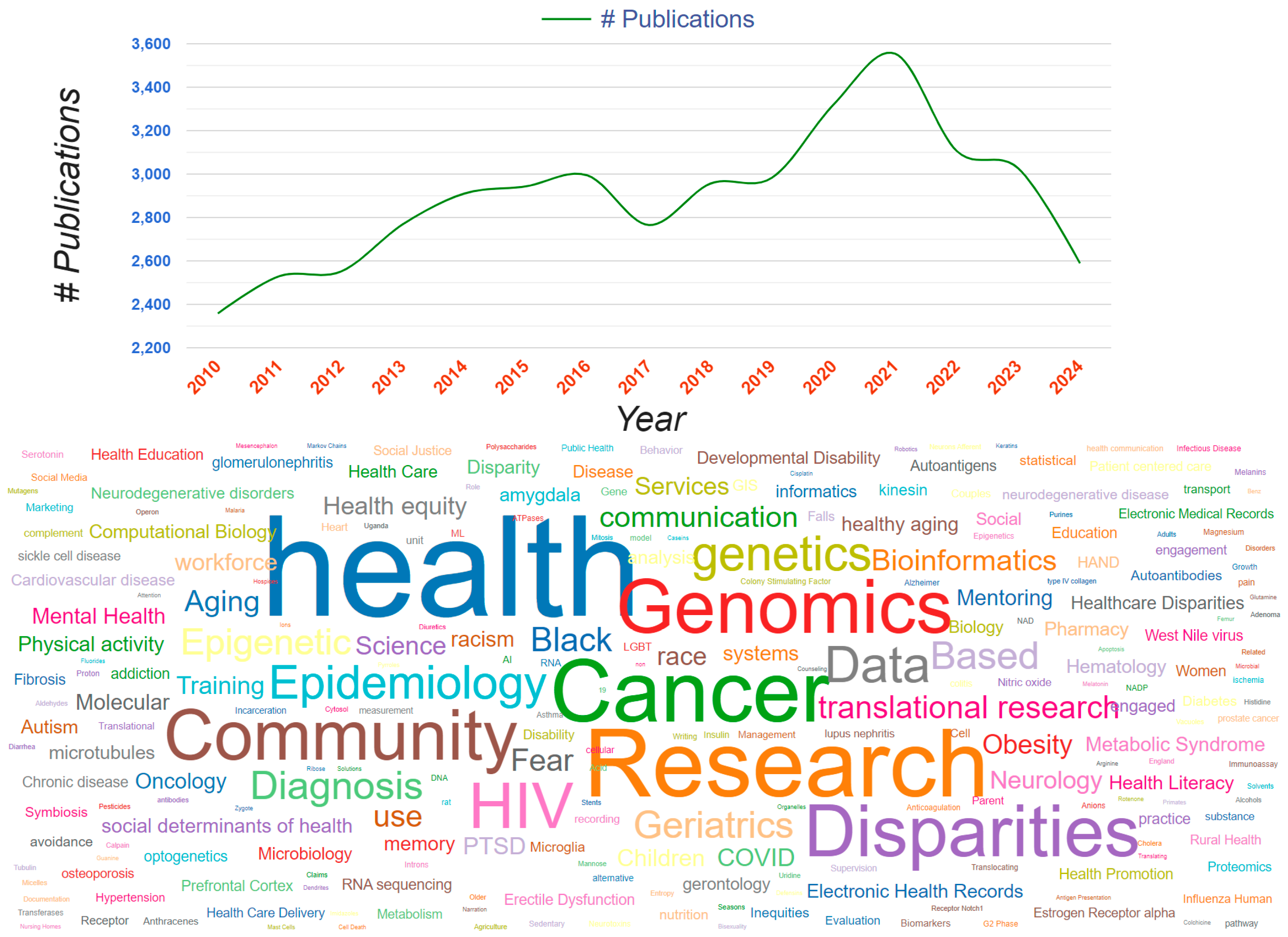
3.5. RCMI Centers-At-a-Glance Data and Word Cloud Feature “Research”, ”Health”, ”Community”, and “Disparities” Align with Publication Top Search Terms (See Figure 6)

3.6. R01 Awards to Investigators Across the RCMI Consortium: NIH RePORTER, 1985–2024 (See Figure 7)
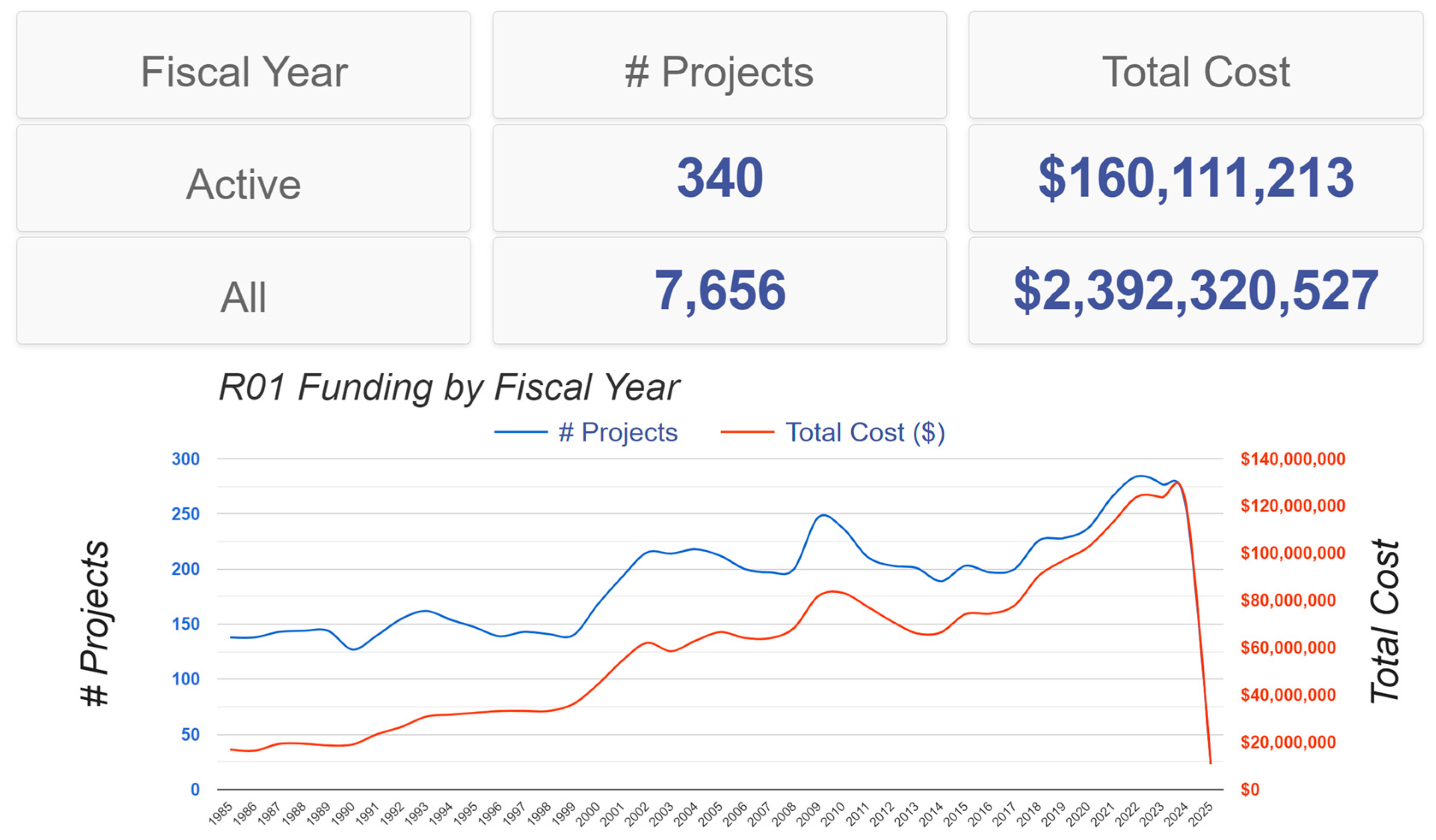
3.7. R01 Projects and Awards from Top 16 Funding NIH Institutes and Centers: NIH RePORTER, 1985–2024 (See Figure 8)
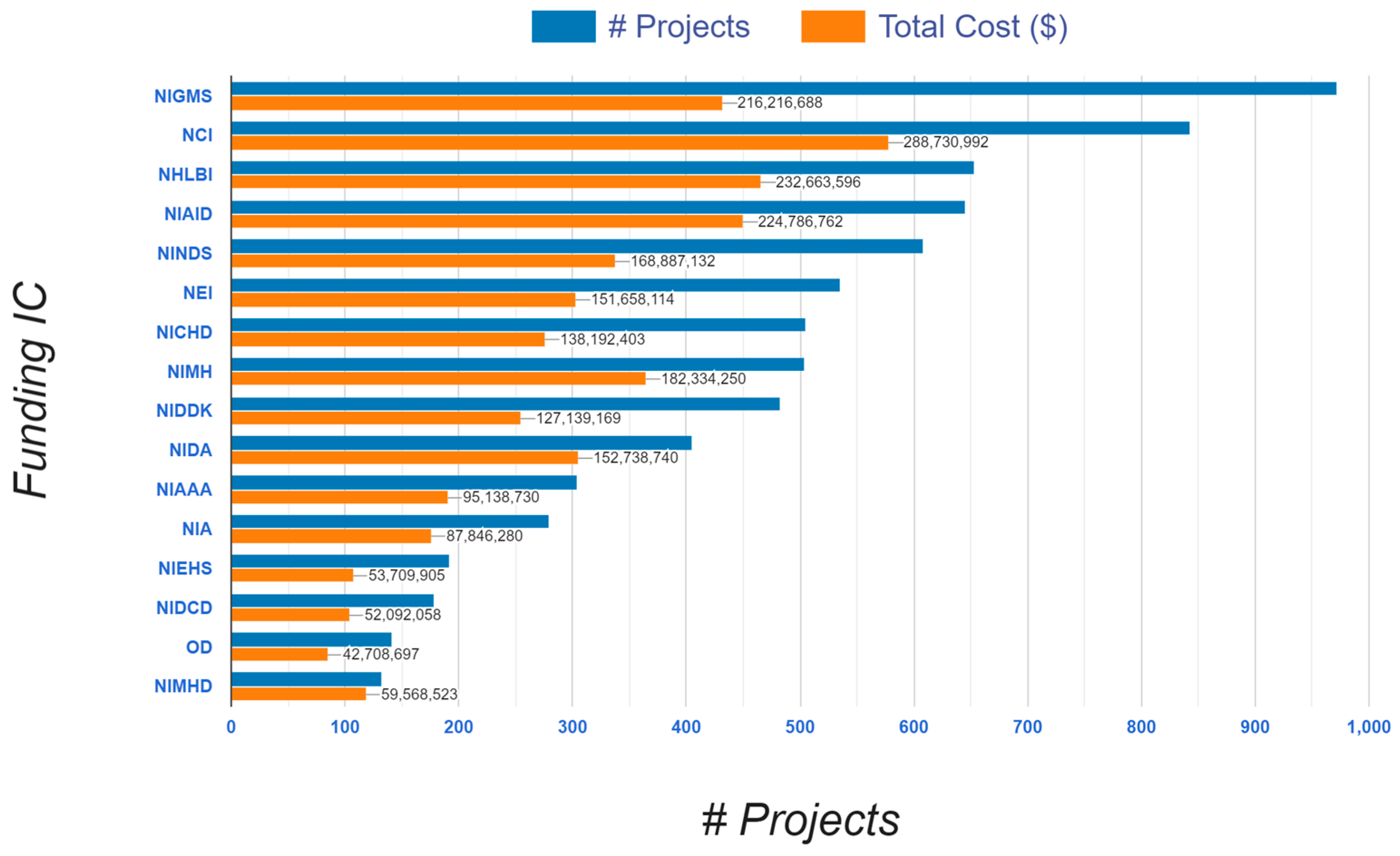
3.8. Return on Investment (ROI) of the RCMI Program: Estimated 4.8 (Data from Base RCMI Program Awards of Between USD 50 Million andUSD 89 Million per Year, Between 1986 and 2024; And Cumulative R01 and R01-Equivalent Awards to RCMI Investigators)
3.9. RCMI Community Engagement Core Signature Programs
3.10. RCMI Patents
3.11. The RCMI Annual Grantees Conference Highlights RCMI Contribution to National Science Advances, Including Innovation in Data Science and Artificial Intelligence
3.12. The RCMI Consortium as a National Research and Mentoring Incubator
4. Discussion
4.1. Limitations
4.2. Implications and Future Plans
5. Conclusions
Author Contributions
Funding
Data Availability Statement
Acknowledgments
Conflicts of Interest
References
- Ofili, E.O.; Tchounwou, P.B.; Fernandez-Repollet, E.; Yanagihara, R.; Akintobi, T.H.; Lee, J.E.; Malouhi, M.; Garner, S.T.; Hayes, T.T.; Baker, A.R.; et al. The Research Centers in Minority Institutions (RCMI) program was established in 1985 in response to committee report language (House Report 98-911) attached to H.R. 6028, the Departments of Labor, Health and Human Services, and Education and Related Agencies Appropriation Act, 1985. Ethn. Dis. 2019, 29, 135–144. [Google Scholar]
- National Institutes of Health Minority Health and Health Disparities Strategic Plan 2021–2025. Available online: https://content.govdelivery.com/accounts/USNIHNIMHD/bulletins/2ca9db6 (accessed on 24 April 2025).
- Collins, F. NIH Research Agenda: How the RCMI Program Contributes. Opening Plenary Keynote Presentation. In Proceedings of the RCMI Translational Science 2017: Innovate, Translate, Collaborate, Engage, Community, Washington, DC, USA, 30 October 2017. [Google Scholar]
- Perez-Stable, E. NIMHD Research Agenda: How the RCMI Program Contributes. Keynote Presentation. In Proceedings of the RCMI Translational Science 2017: Innovate, Translate, Collaborate, Engage, Community, Washington, DC, USA, 30 October 2017. [Google Scholar]
- Tabak, L. NIH Research and Workforce Agenda: How the RCMI Program Contributes. Closing Plenary Keynote Presentation. In Proceedings of the RCMI Translational Science 2017: Innovate, Translate, Collaborate, Engage, Community, Washington, DC, USA, 30 October 2017. [Google Scholar]
- Ofili, E.O.; Sarpong, D.; Yanagihara, R.; Tchounwou, P.B.; Fernández-Repollet, E.; Malouhi, M.; Idris, M.Y.; Lawson, K.; Spring, N.H.; Rivers, B.M. The Research Centers in Minority Institutions (RCMI) Consortium: A Blueprint for Inclusive Excellence. Int. J. Environ. Res. Public Health 2021, 18, 6848. [Google Scholar] [CrossRef] [PubMed] [PubMed Central]
- Smith, S.U.; Hayes, S.; Shea, P. A critical review of the use of Wenger’s Community of Practice (CoP) theoretical framework in online and blended learning research, 2000–2014. Online Learn. 2017, 21, 209–237. [Google Scholar] [CrossRef]
- Wenger, E. Communities of Practice: Learning, Meaning, and Identity; Cambridge University Press: Cambridge, UK, 1999. [Google Scholar]
- Tchounwou, P.B.; Malouhi, M.; Ofili, E.O.; Fernández-Repollet, E.; Sarpong, D.F.; Yanagihara, R.; Aguilera, R.J.; Ayón, C.; Chen, X.; Dasmahapatra, A.; et al. Research Infrastructure Core Facilities at Research Centers in Minority Institutions: Part I—Research Resources Management, Operation, and Best Practices. Int. J. Environ. Res. Public Health 2022, 19, 16979. [Google Scholar] [CrossRef] [PubMed] [PubMed Central]
- Harris, T.; Nunez-Smith, M.; Suttiratana, S.C.; Fretz, S.L.; Leonard, S.; Linnander, E.; Curry, L.A.; the EQBMED Network Partners. Supporting diversity in clinical trials: The equitable breakthroughs in medicine site maturity model. Trials 2024, 25, 764. [Google Scholar] [CrossRef]
- Ofili, E.O.; Tchounwou, P.B.; Fernandez-Repollet, E.; Yanagihara, R.; Akintobi, T.H.; Lee, J.E.; Malouhi, M.; Garner, S.T., Jr.; Hayes, T.T.; Baker, A.R.; et al. The Research Centers in Minority Institutions (RCMI) Translational Research Network: Building and Sustaining Capacity for Multi-Site Basic Biomedical, Clinical and Behavioral Research. Ethn. Dis. 2019, 29 (Suppl. S1), 135–144. [Google Scholar] [CrossRef] [PubMed] [PubMed Central]
- Hedges, J.R.; Soliman, K.F.A.; Southerland, W.M.; D’Amour, G.; Fernández-Repollet, E.; Khan, S.A.; Kumar, D.; Shikuma, C.M.; Rivers, B.M.; Yates, C.C.; et al. Strengthening and Sustaining Inter-Institutional Research Collaborations and Partnerships. Int. J. Environ. Res. Public Health 2021, 18, 2727. [Google Scholar] [CrossRef] [PubMed] [PubMed Central]
- Ofili, E.O.; Fair, A.; Norris, K.; Verbalis, J.G.; Poland, R.; Bernard, G.; Stephens, D.S.; Dubinett, S.M.; Imperato-McGinley, J.; Dottin, R.P.; et al. Models of interinstitutional partnerships between research intensive universities and minority serving institutions (MSI) across the Clinical Translational Science Award (CTSA) consortium. Clin. Transl. Sci. 2013, 6, 435–443. [Google Scholar] [CrossRef] [PubMed] [PubMed Central]
- Fleming, E.S.; Perkins, J.; Easa, D.; Conde, J.G.; Baker, R.S.; Southerland, W.M.; Dottin, R.; Benabe, J.E.; Ofili, E.O.; Bond, V.C.; et al. The role of translational research in addressing health disparities: A conceptual framework. Ethn. Dis. 2008, 18 (Suppl. S2), S2-155-60. [Google Scholar] [PubMed] [PubMed Central]
- Fleming, E.S.; Perkins, J.; Easa, D.; Conde, J.G.; Baker, R.S.; Southerland, W.M.; Dottin, R.; Benabe, J.E.; Ofili, E.O.; Bond, V.C.; et al. Addressing health disparities through multi-institutional, multidisciplinary collaboratories. Ethn. Dis. 2008, 18 (Suppl. S2), S2-161-7. [Google Scholar] [PubMed] [PubMed Central]
- Lee, J.E.; Sung, J.H.; Sarpong, D.; Efird, J.T.; Tchounwou, P.B.; Ofili, E.; Norris, K. Knowledge Management for Fostering Biostatistical Collaboration within a Research Network: The RTRN Case Study. Int. J. Environ. Res. Public Health 2018, 15, 2533. [Google Scholar] [CrossRef] [PubMed] [PubMed Central]
- Sorkness, C.A.; Pfund, C.; Ofili, E.O.; Okuyemi, K.S.; Vishwanatha, J.K.; Zavala, M.E.; Pesavento, T.; Fernandez, M.; Tissera, A.; Deveci, A.; et al. A new approach to mentoring for research careers: The National Research Mentoring Network. BMC Proc. 2017, 11 (Suppl. S12). [Google Scholar] [CrossRef] [PubMed] [PubMed Central]
- Weber-Main, A.M.; McGee, R.; Eide Boman, K.; Hemming, J.; Hall, M.; Unold, T.; Harwood, E.M.; Risner, L.E.; Smith, A.; Lawson, K.; et al. Grant application outcomes for biomedical researchers who participated in the National Research Mentoring Network’s Grant Writing Coaching Programs. PLoS ONE 2020, 15, e0241851. [Google Scholar] [CrossRef] [PubMed] [PubMed Central]
- Vishwanatha, J.; Pfund, C.; Ofili, E.; Okuyemi, K. NIH’s mentoring makes progress. Science 2016, 354, 840–841. [Google Scholar] [CrossRef] [PubMed]
- Hall, M.; Engler, J.; Hemming, J.; Alema-Mensah, E.; Baez, A.; Lawson, K.; Quarshie, A.; Stiles, J.; Pemu, P.; Thompson, W.; et al. Using a Virtual Community (the Health Equity Learning Collaboratory) to Support Early-Stage Investigators Pursuing Grant Funding. Int. J. Environ. Res. Public Health 2018, 15, 2408. [Google Scholar] [CrossRef] [PubMed] [PubMed Central]
- Mubasher, M.; Lawson, K.; Pemu, P.; Pearson, T.; Engler, J.; Baez, A.; Stiles, J.K.; Salazar, M.S.; Caplan, L.S.; Green, K.; et al. Randomized Controlled Study to Test the Effectiveness of Developmental Network Coaching in the Career Advancement of Diverse Early-Stage Investigators (ESIs): Implementation Challenges and Lessons Learned. Int. J. Environ. Res. Public Health 2021, 18, 12003. [Google Scholar] [CrossRef] [PubMed] [PubMed Central]
- Estape, E.S.; Quarshie, A.; Segarra, B.; San Martin, M.; Ríos, R.; Martínez, K.; Ali, J.; Nwagwu, U.; Ofili, E.; Pemu, P. Promoting Diversity in the Clinical and Translational Research Workforce. J. Natl. Med. Assoc. 2018, 110, 598–605. [Google Scholar] [CrossRef] [PubMed] [PubMed Central]
- Strekalova, Y.A.L.; Kornetti, D.L.; Wang, R.; Báez, A.; Caplan, L.S.; Idris, M.Y.; Lawson, K.; Holmes, J.; Mubasher, M.; Pemu, P.; et al. Individual and Institutional Factors Contribute to Research Capacity Building for Early-Stage Investigators from Groups Underrepresented in Biomedical Research: A Qualitative Comparative Analysis. Int. J. Environ. Res. Public Health 2023, 20, 5662. [Google Scholar] [CrossRef] [PubMed] [PubMed Central]
- Mubasher, M.; Pearson, T.; Idris, M.Y.; Lawson, K.; Holmes, J.; Pemu, P.; Baez, A.; Stiles, J.K.; Salazar, M.S.; Thompson, W.E.; et al. The Role of Mock Reviewing Sessions in the National Research Mentoring Network Strategic Empowerment Tailored for Health Equity Investigators: A Randomized Controlled Study. Int. J. Environ. Res. Public Health 2023, 20, 5738. [Google Scholar] [CrossRef] [PubMed] [PubMed Central]
- Johnson Hemming, J.; Baez, A.; Hall, M.; Thompson, W.; Stiles, J.; Ofili, E. Advancing Health Equity through Organizational Mentoring Policies at Minority-Serving Institutions. Ethn. Dis. 2019, 29 (Suppl. S2), 371–376. [Google Scholar] [CrossRef] [PubMed] [PubMed Central]
- Báez, A.; Idris, M.Y.; Lawson, K.; Mubasher, M.; Strekalova, Y.; Green, K.; Pemu, P.; Stiles, J.K.; Salazar, M.; Quarshie, A.; et al. Impact of COVID-19 on the Research Career Advancement of Health Equity Scholars from Diverse Backgrounds. Int. J. Environ. Res. Public Health 2023, 20, 4750. [Google Scholar] [CrossRef] [PubMed] [PubMed Central]
- Campo, M.S.; Livas, S.M.; Madamba, T.R.; Ofili, E. Mentoring Networks in Academic Medicine: A Longitudinal Exploration. Chron. Mentor. Coach. 2024, 8, 72–81. [Google Scholar] [CrossRef] [PubMed] [PubMed Central]
- Stephens, D.S.; West, A.C.; Ofili, E.O.; Boyan, B.D.; Blumberg, H.M. The Atlanta Clinical and Translational Science Institute: Clinical and translational science education and training partnership. Clin. Transl. Sci. 2011, 4, 143–145. [Google Scholar] [CrossRef] [PubMed] [PubMed Central]
- Haynes, N.A.; Johnson, M.; Lewsey, S.C.; Alexander, K.M.; Anstey, D.E.; Dillenburg, T.; Njoroge, J.N.; Gordon, D.; Ofili, E.O.; Yancy, C.W.; et al. Nurturing Diverse Generations of the Medical Workforce for Success with Authenticity: An Association of Black Cardiologists’ Roundtable. Circ. Cardiovasc. Qual. Outcomes 2023, 16, e009032. [Google Scholar] [CrossRef] [PubMed]
- Awad, C.S.; Deng, Y.; Kwagyan, J.; Roche-Lima, A.; Tchounwou, P.B.; Wang, Q.; Idris, M.Y. Summary of Year-One Effort of the RCMI Consortium to Enhance Research Capacity and Diversity with Data Science. Int. J. Environ. Res. Public Health 2022, 20, 279. [Google Scholar] [CrossRef] [PubMed] [PubMed Central]
- Levites Strekalova, Y.A.; Kornetti, D.L.; Pemu, P.; King Gordon, T.; Kumar, D.; Brown, M.; Spires, S.; Ofili, E.O. Strategic Team Science Promotes Collaboration and Practice-Based Research at the Research Centers in Minority Institutions. Int. J. Environ. Res. Public Health 2023, 20, 4800. [Google Scholar] [CrossRef] [PubMed] [PubMed Central]
- Mandl, K.D.; Kohane, I.S.; McFadden, D.; Weber, G.M.; Natter, M.; Mandel, J.; Schneeweiss, S.; Weiler, S.; Klann, J.G.; Bickel, J.; et al. Scalable Collaborative Infrastructure for a Learning Healthcare System (SCILHS): Architecture. J. Am. Med. Inform. Assoc. 2014, 21, 615–620. [Google Scholar] [CrossRef] [PubMed] [PubMed Central]
- Estiri, H.; Klann, J.G.; Weiler, S.R.; Alema-Mensah, E.; Joseph Applegate, R.; Lozinski, G.; Patibandla, N.; Wei, K.; Adams, W.G.; Natter, M.D.; et al. A federated EHR network data completeness tracking system. J. Am. Med. Inform. Assoc. 2019, 26, 637–645. [Google Scholar] [CrossRef] [PubMed] [PubMed Central]
- Burns, A.; Yeager, V.A.; Vest, J.R.; Harle, C.A.; Madsen, E.R.; Cronin, C.E.; Singh, S.; Franz, B. New insights about community benefit evaluation: Using the Community Health Implementation Evaluation Framework to assess what hospitals are measuring. Health Care Manag. Rev. 2024, 49, 229–238. [Google Scholar] [CrossRef] [PubMed]
- Luke, D.A.; Sarli, C.C.; Suiter, A.M.; Carothers, B.J.; Combs, T.B.; Allen, J.L.; Beers, C.E.; Evanoff, B.A. The Translational Science Benefits Model: A New Framework for Assessing the Health and Societal Benefits of Clinical and Translational Sciences. Clin. Transl. Sci. 2018, 11, 77–84. [Google Scholar] [CrossRef] [PubMed] [PubMed Central]
- Elmore, S.A. The Altmetric Attention Score: What Does It Mean and Why Should I Care? Toxicol. Pathol. 2018, 46, 252–255. [Google Scholar] [CrossRef] [PubMed] [PubMed Central]
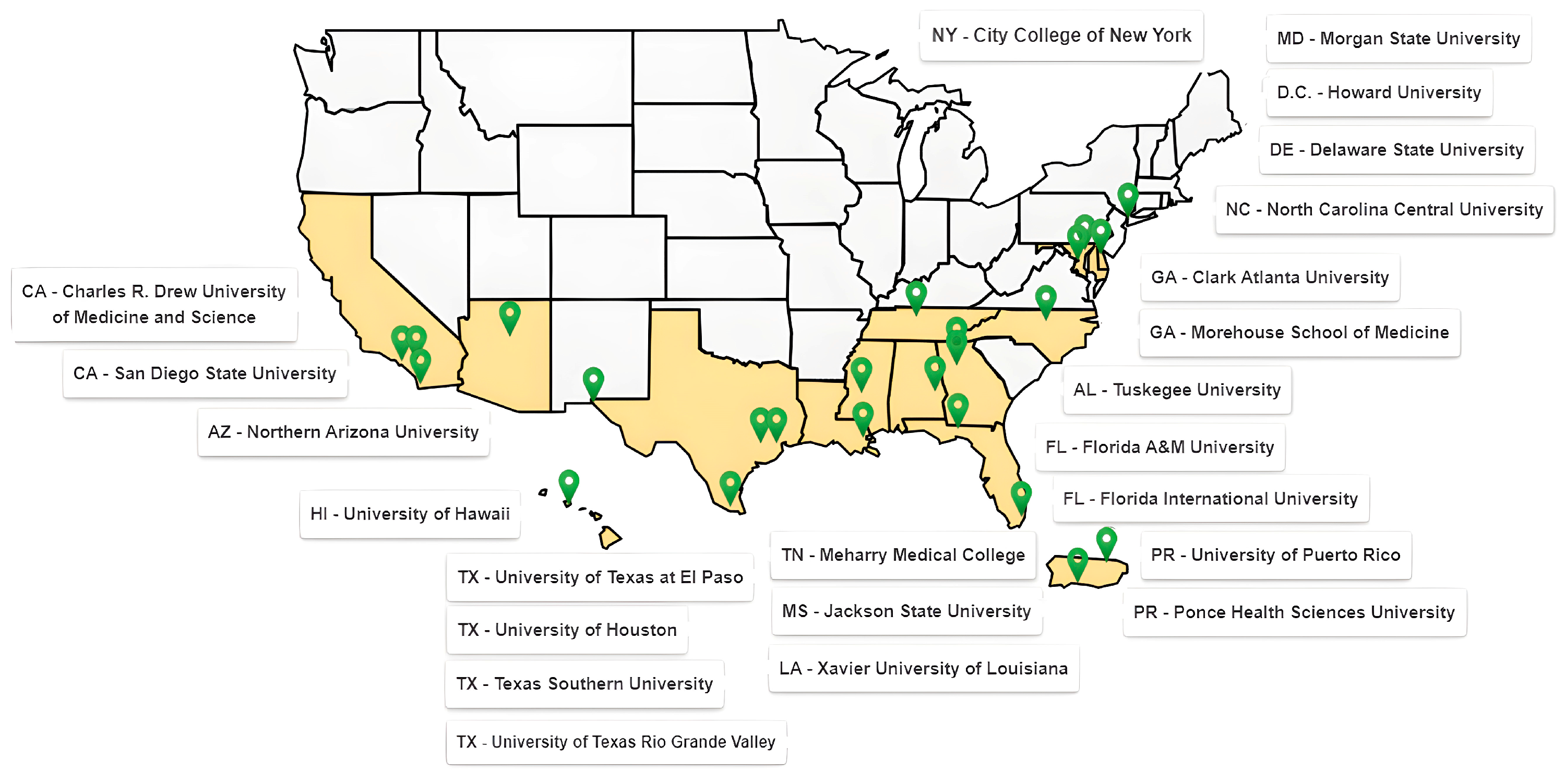


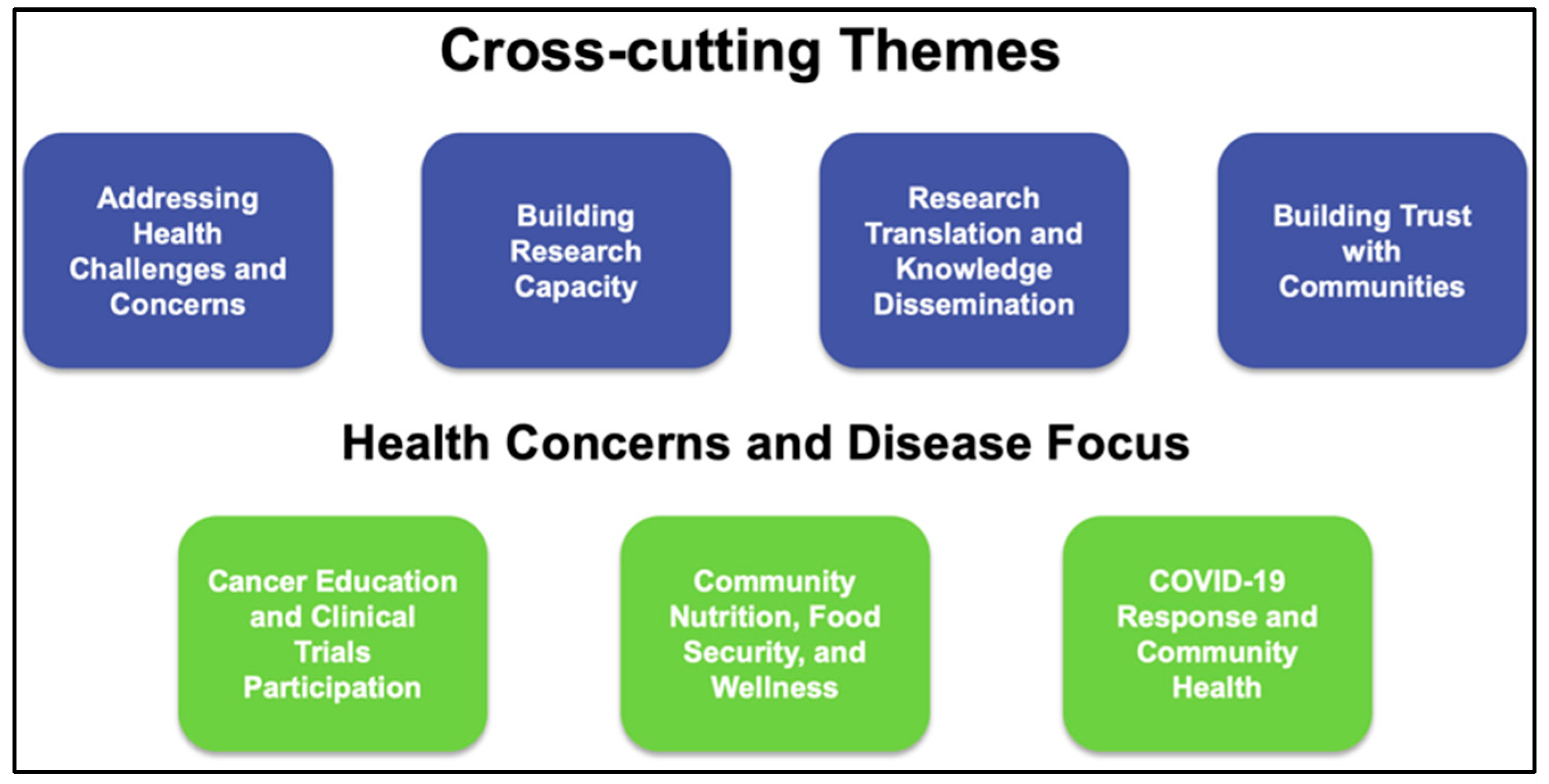

Disclaimer/Publisher’s Note: The statements, opinions and data contained in all publications are solely those of the individual author(s) and contributor(s) and not of MDPI and/or the editor(s). MDPI and/or the editor(s) disclaim responsibility for any injury to people or property resulting from any ideas, methods, instructions or products referred to in the content. |
© 2025 by the authors. Licensee MDPI, Basel, Switzerland. This article is an open access article distributed under the terms and conditions of the Creative Commons Attribution (CC BY) license (https://creativecommons.org/licenses/by/4.0/).
Share and Cite
Ofili, E.O.; Malouhi, M.; Sarpong, D.F.; Tchounwou, P.B.; Fernandez-Repollet, E.; Chang, S.P.; Gordon, T.K.; Mubasher, M.; Quarshie, A.; Strekalova, Y.; et al. The NIH Research Centers in Minority Institutions (RCMI): National and Public Health Impact as Measured by Collaborative Scientific Excellence, Investigator Development, and Community Engagement. Int. J. Environ. Res. Public Health 2025, 22, 1650. https://doi.org/10.3390/ijerph22111650
Ofili EO, Malouhi M, Sarpong DF, Tchounwou PB, Fernandez-Repollet E, Chang SP, Gordon TK, Mubasher M, Quarshie A, Strekalova Y, et al. The NIH Research Centers in Minority Institutions (RCMI): National and Public Health Impact as Measured by Collaborative Scientific Excellence, Investigator Development, and Community Engagement. International Journal of Environmental Research and Public Health. 2025; 22(11):1650. https://doi.org/10.3390/ijerph22111650
Chicago/Turabian StyleOfili, Elizabeth O., Mohamad Malouhi, Daniel F. Sarpong, Paul B. Tchounwou, Emma Fernandez-Repollet, Sandra P. Chang, Tandeca King Gordon, Mohamed Mubasher, Alexander Quarshie, Yulia Strekalova, and et al. 2025. "The NIH Research Centers in Minority Institutions (RCMI): National and Public Health Impact as Measured by Collaborative Scientific Excellence, Investigator Development, and Community Engagement" International Journal of Environmental Research and Public Health 22, no. 11: 1650. https://doi.org/10.3390/ijerph22111650
APA StyleOfili, E. O., Malouhi, M., Sarpong, D. F., Tchounwou, P. B., Fernandez-Repollet, E., Chang, S. P., Gordon, T. K., Mubasher, M., Quarshie, A., Strekalova, Y., Lee, E., Stiles, J., Pemu, P., Baez, A., Caplan, L., Idris, M. Y., Pearson, T., Holmes, J., Harris, C., ... The RCMI Consortium. (2025). The NIH Research Centers in Minority Institutions (RCMI): National and Public Health Impact as Measured by Collaborative Scientific Excellence, Investigator Development, and Community Engagement. International Journal of Environmental Research and Public Health, 22(11), 1650. https://doi.org/10.3390/ijerph22111650












